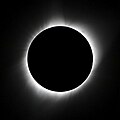| Annular eclipse | |
| Gamma | −0.1242 |
|---|---|
| Magnitude | 0.9838 |
| Maximum eclipse | |
| Duration | 117 s (1 min 57 s) |
| Coordinates | 12°48′N133°42′E / 12.8°N 133.7°E |
| Max. width of band | 58 km (36 mi) |
| Times (UTC) | |
| Greatest eclipse | 3:10:32 |
| References | |
| Saros | 137 (39 of 70) |
| Catalog # (SE5000) | 9674 |
An annular solar eclipse will occur at the Moon's ascending node of orbit on Tuesday, July 24, 2074, [1] with a magnitude of 0.9838. A solar eclipse occurs when the Moon passes between Earth and the Sun, thereby totally or partly obscuring the image of the Sun for a viewer on Earth. An annular solar eclipse occurs when the Moon's apparent diameter is smaller than the Sun's, blocking most of the Sun's light and causing the Sun to look like an annulus (ring). An annular eclipse appears as a partial eclipse over a region of the Earth thousands of kilometres wide. Occurring about 5.6 days after perigee (on July 18, 2074, at 13:55 UTC), the Moon's apparent diameter will be larger. [2]
Contents
- Eclipse details
- Eclipse season
- Related eclipses
- Eclipses in 2074
- Metonic
- Tzolkinex
- Half-Saros
- Tritos
- Solar Saros 137
- Inex
- Triad
- Solar eclipses of 2073–2076
- Saros 137
- Metonic series
- Tritos series
- Inex series
- References
- External links
The path of annularity will be visible from parts of the Maldives, the Andaman and Nicobar Islands, Thailand, Cambodia, Vietnam, the Philippines, Micronesia, and Tuvalu. A partial solar eclipse will also be visible for parts of South Asia, Southeast Asia, East Asia, northern Australia, and Oceania.






































































































